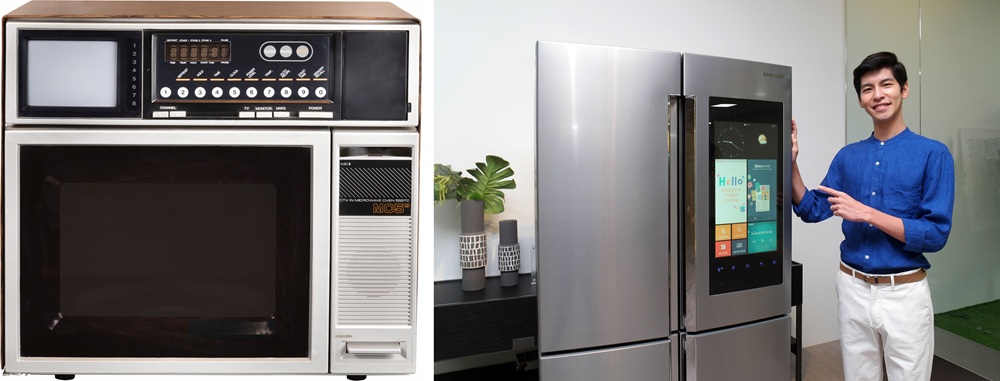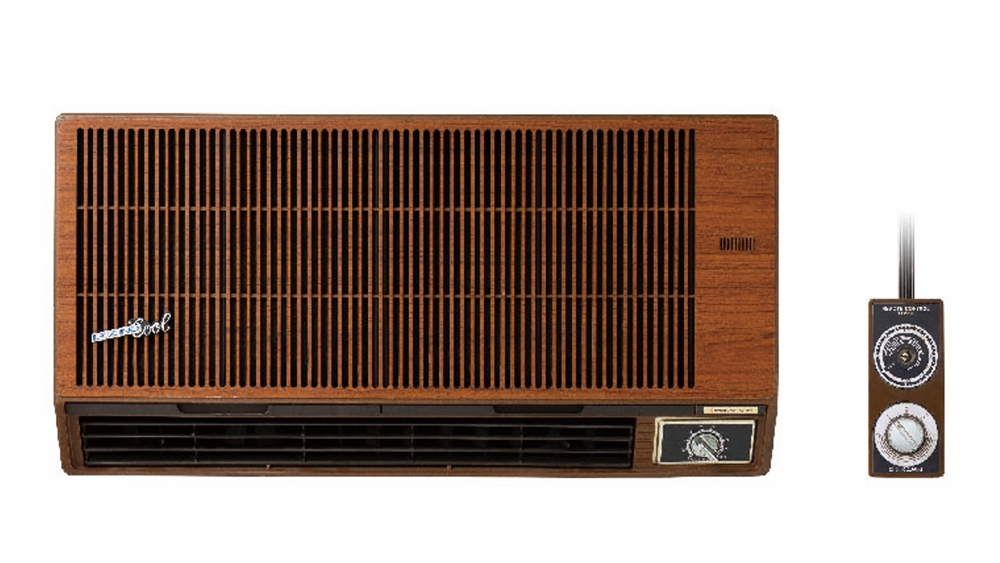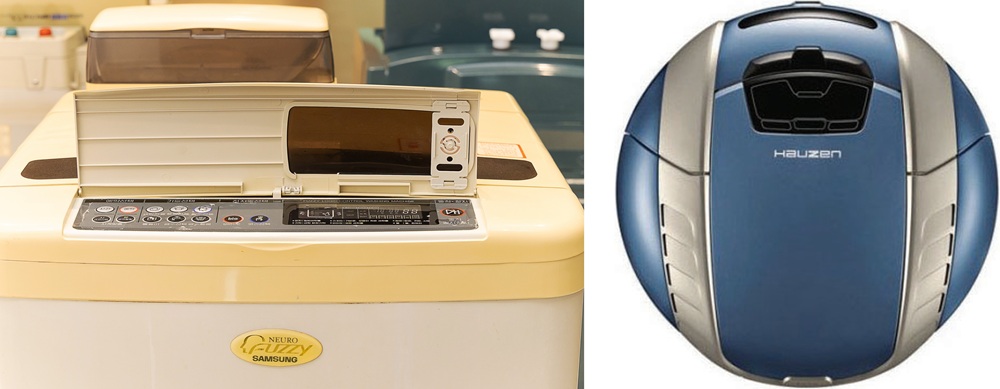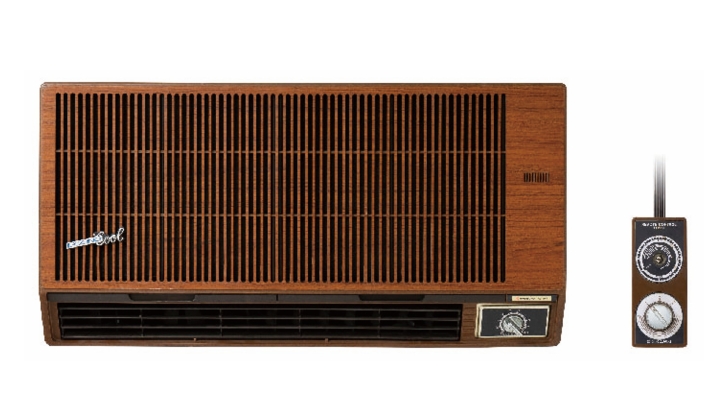The appliance innovation legacy of Samsung Electronics extends from microwave ovens with TVs and talking refrigerators to IoT-enabled refrigerators. These appliances have steadily evolved into today’s Bespoke AI lineup — products that understand users and provide personalized solutions.
Under the theme “AI Home: Future Living, Now,” Samsung will present an advanced AI Home experience1 at IFA 2025, Europe’s largest home appliance exhibition, taking place in Berlin from September 5-9.
As the event draws nearer, Samsung Newsroom is taking a closer look at the company’s innovation trajectory and how its appliances have advanced into the future.
From the Talking Refrigerator to Bixby, and Now a Voice-Connected Home
Samsung marked the beginning of voice-enabled appliances in 1985 with the debut of its Talking Refrigerator. Later equipped with early speech synthesis technology in 1989, the product went beyond simple voice guidance by offering scheduled playback of recordings, a family memo feature and door-open alerts — laying the foundation for AI-enabled voice interaction.
This early innovation eventually evolved into Bixby,2 Samsung’s AI voice assistant introduced in 2018. Bixby has since become the intelligence and control hub of the company’s home appliances, enabling voice control across refrigerators, air conditioners, washing machines and more. With Voice ID,3 the AI assistant can now even recognize individual users to provide customized information.
▲ (left) Talking Refrigerator, (right) Bixby’s Voice ID feature can recognize individual users
Appliance Screens, Now the Hub of the Home
Samsung was an early pioneer of the concept of “screen appliances,” presenting a vision for the future of connected homes. In 1982, the company introduced a multi-purpose microwave with a screen, which not only allowed users to check cooking instructions but also watch TV and even monitor home entry with surveillance camera functions. Later, Samsung expanded the role of the screen to refrigerators, transforming them from simple storage units into the hub of daily family life.
In 2016, Samsung launched the Family Hub refrigerator — an IoT-enabled fridge. Equipped with a 21.5-inch touchscreen and internal cameras, it allowed users to check the status of their food items and manage grocery shopping online, opening up a completely new kitchen experience. Since then, refrigerators, washing machines, air conditioners and other appliances have been connected through SmartThings,4 with screens that have evolved into control hubs that let users monitor and manage smart devices throughout the home at a glance.

▲ (left) Multi-purpose microwave, (right) Family Hub refrigerator launched in 2016
From Neuro-Fuzzy Washers to Bespoke AI: The Evolution of Intelligent Appliances
Samsung took its first step toward intelligent appliances in 1980 with the launch of an air conditioner embedded with a microcomputer chip. This spirit of innovation continued into the 1990s, when Samsung launched the Neuro-Fuzzy washing machine which features the fuzzy logic IC5 and neuro-algorithms, in 1991. Using optical sensors, it detected soil level, load size and water temperature, then automatically optimized the wash cycle — introducing the concept of appliances that sense, decide and deliver personalized solutions.

▲ Air conditioner embedded with a microcomputer chip
In 2018, Samsung launched the QuickDrive washing machine, which applied AI-based curation to recommend wash cycles based on fabric type, color and soil level. This innovation laid the groundwork for the Bespoke AI Laundry Combo, equipped with OptiWash and AI Optimal Dry, which automatically detect fabric types and soil levels to deliver optimized wash cycles and drying temperatures.6
Samsung also brought intelligence to vacuum cleaners with the Hauzen robot vacuum in 2006. Using a gyro sensor, it calculated distance and angles to map out optimal cleaning routes through self-mapping capabilities. This marked a shift from simple dust collection to appliances capable of responding to their environment. Today’s Bespoke Jet Bot Combo builds on this legacy with advanced security and AI-powered camera sensors that recognize and avoid objects,7 distinguish floor types8 and navigate more intelligently.

▲ (left) Neuro-Fuzzy washing machine, (right) Hauzen robot vacuum
Innovative Appliance Lineup at IFA: An AI Home Tailored to You
At IFA 2025, Samsung will showcase an even more advanced AI Home, powered by its 2025 Bespoke AI appliance lineup.
“Based on Samsung’s legacy of innovation, we will continue to deliver greater convenience and value in users’ daily lives,” said Jeong Seung Moon, EVP and Head of the R&D Team at Samsung Electronics’ Digital Appliances (DA) Business. “By setting a new standard for personalized AI Home experiences, we aim to further solidify the idea that ‘Samsung = AI appliances.’”
1 AI-based features are available on certain appliances, and based on our deep learning model, which is trained using a predefined set of data and may yield incomplete or incorrect information. New datasets may be introduced to our learning model from time to time to enhance its accuracy.
2 Bixby is Samsung’s brand of Internet of Things (IoT) voice assistant. Bixby service availability may vary depending on country. Bixby recognizes selected languages and certain accents/dialects. The user interface may change and differ by device. The availability of Bixby features and content providers may vary depending on the country/carrier/language/device model/OS version. A Samsung account log-in and data network connection (Wi-Fi or data network) are required. Users must agree to the update to use this function.
3 The Voice ID feature on Samsung home appliances supports registration of up to six users. Currently available on select Samsung Family Hubs and refrigerators and may vary by model and region. Each user must register for a Samsung Account on screen appliances in advance. The Calendar app supports integration with Google and Microsoft, and may vary by model and region.
4 Available on Android and iOS devices. A Wi-Fi connection and a Samsung account are required.
5 Fuzzy logic is an approach to computing that mimics human reasoning by using degrees of truth instead of strict yes/no values, and an integrated circuit (IC) is a chip that contains electronic circuits to perform specific functions.
6 Fabric sensing uses an AI algorithm to sense certain types of fabric types for loads up to 8 lbs. A turbidity sensor operates for all weights. Mixed fabrics may reduce detection accuracy. Actual results may vary depending on individual use. To prevent wear, wash and dry like fabrics together.
7 Object recognition may be affected by an object’s shape or the environmental conditions. Only certain object types can be recognized. Stained Area Recognition needs to be activated beforehand via the SmartThings App. A Wi-Fi connection and Samsung account are required.
8 Based on our deep learning model trained using a predefined set of data and may yield incomplete or incorrect information. New datasets may be introduced to our learning model from time to time to enhance its accuracy.
